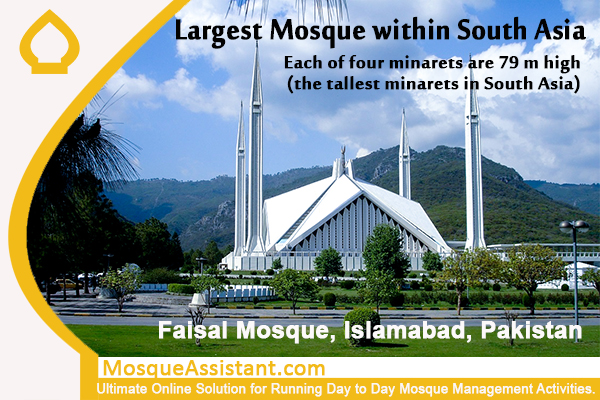
The Faisal Mosque, situated in Pakistan’s capital city, Islamabad, is the national mosque and stands as a prominent architectural marvel. As the fifth-largest mosque globally and the largest in South Asia, it is nestled against the scenic backdrop of the Margalla Hills.
This mosque boasts a contemporary design, characterized by its unique eight-sided concrete shell structure, inspired by the traditional form of a Bedouin tent. Construction of the mosque commenced in 1976, thanks to a generous $28 million grant from Saudi King Faisal, in whose honor the mosque is named. Turkish architect Vedat Dalokay’s unconventional design, selected through an international competition, sets the Faisal Mosque apart. It eschews the conventional dome and instead takes the shape of a Bedouin tent, flanked by four towering minarets that soar to a height of 260 feet (79 meters).
The mosque’s design encompasses eight-sided sloping roofs, creating a triangular worship hall capable of accommodating 10,000 worshippers. With a sprawling expanse of 33 acres (130,000 square meters), the Faisal Mosque dominates Islamabad’s landscape, perched atop an elevated area, against the backdrop of a picturesque national park. Notably, it held the title of the world’s largest mosque from 1986 to 1993 when it was surpassed by mosques in Saudi Arabia. Currently, it ranks as the sixth largest mosque globally in terms of capacity.
The Faisal Mosque boasts the remarkable ability to host approximately 300,000 worshippers. Its four minarets, each towering to a height of 79 meters (259 feet) and measuring 10×10 meters in circumference, are the tallest minarets in South Asia. Within its premises, the mosque’s main areas, including the inner hall and courtyards, can comfortably accommodate up to 74,000 people. The grounds surrounding the mosque have a vast capacity, capable of holding up to 200,000 individuals, solidifying the Faisal Mosque’s significance as a symbol of grandeur and spirituality in Pakistan.
